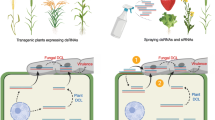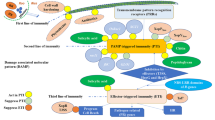Abstract
Leaf blast suppression in multilines was evaluated based on the number of susceptible lesions observed in a pure stand of susceptible rice cultivar Sasanishiki, and in 1 : 1 and 1 : 3 mixtures of Sasanishiki and a resistant near-isogenic line, Sasanishiki BL4 or BL7, from 1998 to 2001. The number of lesions first observed in fields in the 1 : 1 and 1 : 3 mixtures were close to theoretical numbers calculated using the number of lesions observed in the pure stands and the ratios of the susceptible Sasanishiki in the mixtures. The ratio of the number of lesions in the 1 : 1 and 1 : 3 mixtures to the number in the pure stand was 0.29 and 0.09, respectively. The relationship between these ratios and the ratios of susceptible Sasanishiki in mixtures was defined in an equation to estimate the degree of leaf blast suppression. Validation studies for the ratios of the number of lesions in the 1 : 1 and 1 : 3 mixtures to the number in the pure stand were conducted in two different locations and showed that the ratios are almost acceptable. The calculated autoinfection to alloinfection ratio was 1.3 and 1.4 in the 1 : 1 and 1 : 3 mixtures, respectively, suggesting that the calculated ratio will affect the degree of leaf blast suppression. Thus, predictors were obtained to estimate leaf blast suppression for effective blast control in multilines.
Similar content being viewed by others
References
ME Barr (1977) ArticleTitleMagnaporthe, Telimenella and Hyponectria (Physosphorellaceae) Mycologia 69 952–956
Bonman JM, Estrada BA, Denton RI (1986) Blast management with upland rice cultivar mixtures. Proceedings of the Symposium on Progress in Upland Rice Research, IRRI, Los Banos, Laguna, Philippines, pp 375–382
NE Borlaug (1953) ArticleTitleNew approach to the breeding of wheat varieties resistant to Puccinia graminis tritici Phytopathology 43 467
Borlaug NE (1959) The use of multilineal or composite varieties to control airborne epidemic diseases of self-pollinated crop plants. In: Jenkins BC (ed) First International Wheat Genetics Symposium, Winnipeg, pp 12–16
JA Browning KJ Frey (1969) ArticleTitleMultiline cultivars as a means of disease control Ann Rev Phytopathol 7 355–382 Occurrence Handle10.1146/annurev.py.07.090169.002035
KM Chin AN Husin (1982) Rice variety mixtures. Proceedings of the Padi Workshop Bumbong Lima Province Wellesley, Malaysia 203–206
SH Chiu YC Teng (1975) ArticleTitleYield and resistance of rice blast resistant composite varieties (in Chinese with English summary) J Agric Res 24 1–10
SH Chiu YC Teng (1976) ArticleTitleStudies on disease resistance, yield capacity and grain quality of blast resistant multiline and composite varieties of rice (in Chinese with English summary) J Agric Res 25 249–258
HS Chung CY Lee JY Cho EW Lee (1987) ArticleTitleEffects of cultivar mixtures on rice blast epidemics and yields in the paddy field J Natl Acad Sci Korea 26 341–361
KA Garrett CC Mundt (1999) ArticleTitleEpidemiology in mixed host populations Phytopathology 89 984–990 Occurrence Handle1:STN:280:DC%2BD1cjjsl2nuw%3D%3D Occurrence Handle18944652
A Hashimoto K Hirano K Matsumoto (1984) ArticleTitleStudies on the forecasting of rice leaf blast development by application of the computer simulation (in Japanese with English summary) Sp Bull Fukushima Pref Exp Stn 2 1–104
T Hori T Kuroda Y Sasaki K Ishikawa T Ashizawa (2004) ArticleTitleThe applicability of the multiline simulation model (BLASTMUL) to rice multiline ‘Koshihikari Niigata BL’ in Niigata (in Japanese) Jpn J Phytopathol 70 231
NF Jensen (1952) ArticleTitleIntra-varietal diversification in oat breeding Agron J 44 30–34 Occurrence Handle10.2134/agronj1952.00021962004400010009x
J Kobayashi (1984) ArticleTitleStudies on epidemic of rice leaf blast, Pyricularia oryzae Cav., in its early stage (in Japanese with English summary) Bull Akita Agric Exp Stn 26 1084
Y Kojima T Ebitani M Doi T Ishibashi Y Kidani N Mukaino T Yamaguchi M Omoteno Y Yamamoto (2003) ArticleTitleDevelopment and utilization of isogenic lines Koshihikari Toyama. I. Development of isogenic lines Koshihikari Toyama BL (in Japanese with English summary) Bull Toyama Agric Res Cent 20 13–32
DR Marshall (1989) Modeling the effects of multiline varieties on the population genetics of plant pathogens KJ Leonard WE Frey (Eds) Plant disease epidemiology, vol 2 Springer Berlin Heidelberg New York 248–317
CC Mundt (1994) Use of host genetic diversity to control cereal diseases: implications of rice blast RS Zeigler SA Leong PS Teng (Eds) Rice blast disease CAB International Wallingford, UK 293–308
CC Mundt LS Brophy (1988) ArticleTitleInfluence of number of host genotype units on the effectiveness of host mixtures for disease control: a modeling approach Phytopathology 78 1087–1094
A Ohba J Oyama S Ishikawa M Sasahara T Ashizawa (2005) ArticleTitleUsing BLASTMUL, a leaf blast model of rice, for determining the mixture composition of Sasanishiki blast resistant near-isogenic lines in Miyagi Prefecture (in Japanese) Jpn J Phytopathol 71 45
RA Robinson (1976) Plant pathosystems Springer Berlin Heidelberg New York
AY Rossman RJ Howard B Valent (1990) ArticleTitlePyricularia grisea, the correct name for the rice blast fungus Mycologia 82 509–512
T Sasaki S Abe K Matsushita E Okamoto K Nagano K Takano Y Chiba A Kano K Uematsu H Takizawa H Hayasaka S Wakui T Kuroda S Usuki B Chiba N Miyano K Sasaki T Endo (2002) ArticleTitleMultiline rice variety of Sasanishiki “Sasanishiki BL” (in Japanese with English summary) Bull Miyagi Pref Furukawa Agric Exp Stn 3 1–35
R Yoshino (1979) ArticleTitleEcological studies on penetration of rice blast fungus, Pyricularia oryzae, into leaf epidermal cells (in Japanese with English summary) Bull Hokuriku Agric Exp Stn 22 163–221
Author information
Authors and Affiliations
Corresponding author
Rights and permissions
About this article
Cite this article
Ashizawa, T., Sasahara, M., Ohba, A. et al. Lesion-based analysis of leaf blast suppression in mixture of rice cultivar and a resistant near-isogenic line. J Gen Plant Pathol 73, 15–21 (2007). https://doi.org/10.1007/s10327-006-0321-9
Received:
Accepted:
Published:
Issue Date:
DOI: https://doi.org/10.1007/s10327-006-0321-9




